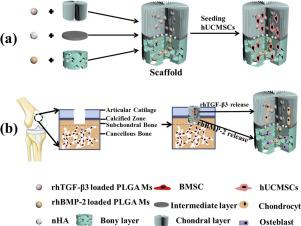Applied Materials Today ( IF 7.2 ) Pub Date : 2019-12-30 , DOI: 10.1016/j.apmt.2019.100548 Yunsheng Dong , Xun Sun , Zhiling Zhang , Yufei Liu , Lin Zhang , Xiangyun Zhang , Ying Huang , Yanhong Zhao , Chunxiao Qi , Adam C. Midgley , Shufang Wang , Qiang Yang

|
Mesenchymal stem cells (MSCs) are considered to be important cell sources for tissue regeneration. Growth factors (GFs) are key mediators of MSCs chondrogenesis and osteogenesis in the enhancement of osteochondral repair. However, uncontrolled delivery and release of these bioactive factors may reduce their bioavailability and lead to off-target side effects. In this study, tri-layered scaffolds, based on the chondrocyte extracellular matrix, nano-hydroxyapatite and silk fibroin were prepared by imitating the structural layers of the osteochondral unit. Particularly, tri-layered scaffolds were functioned for the local and sustained release of transforming growth factor-β3 to the chondral layer and bone morphogenetic protein-2 to the bony layer. In conjunction with engrafted human umbilical cord mesenchymal stem cells (hUCMSCs), osteochondral regeneration was enhanced. In vitro experiments indicated that scaffolds supported hUCMSCs proliferation, vitality and adhesion, and facilitated hUCMSCs lineage differentiation toward chondrocytes or osteoblasts, dependent on stimulation by sustained GFs release, at chondral layer or bony layer, respectively. Furthermore, evaluation of osteochondral repair in vivo after 8- and 16-weeks post-implantation indicated that the tri-layered scaffolds with sustained release function and hUCMSC delivery significantly accelerated the repair of large-size osteochondral defects, compared with other scaffolds. In summary, our studies showed that tri-layered scaffolds with the biomimetic structure of osteochondral unit, with sustained GFs release and seeded with hUCMSCs were more conducive to osteochondral regeneration, providing new materials and strategies for tissue engineering for the repair large-scale osteochondral defects.
中文翻译:

仿生三层支架修复生长因子的区域性和持续性双重释放,以修复大规模骨软骨缺损
间充质干细胞(MSCs)被认为是组织再生的重要细胞来源。生长因子(GFs)是MSCs软骨形成和成骨作用的关键介质,可促进骨软骨修复。但是,这些生物活性因子的不受控制的传递和释放可能会降低其生物利用度并导致脱靶副作用。在这项研究中,通过模仿骨软骨单元的结构层,制备了基于软骨细胞细胞外基质,纳米羟基磷灰石和丝素蛋白的三层支架。特别地,三层支架的功能是将转化生长因子-β3局部持续释放到软骨层,将骨形态发生蛋白-2释放到骨层。结合植入的人脐带间充质干细胞(hUCMSC),体外实验表明,支架在软骨层或骨层分别支持hUCMSCs的增殖,活力和粘附,并促进hUCMSCs向软骨细胞或成骨细胞的谱系分化,这取决于持续释放的GFs。此外,体内骨软骨修复的评估植入后8周和16周后的结果表明,与其他支架相比,具有持续释放功能和hUCMSC递送的三层支架显着促进了大型骨软骨缺损的修复。总之,我们的研究表明,具有仿生结构的骨软骨单元,持续释放GFs以及hUCMSCs植入的三层支架更有利于骨软骨再生,为修复大规模骨软骨缺损的组织工程提供了新的材料和策略。 。











































 京公网安备 11010802027423号
京公网安备 11010802027423号